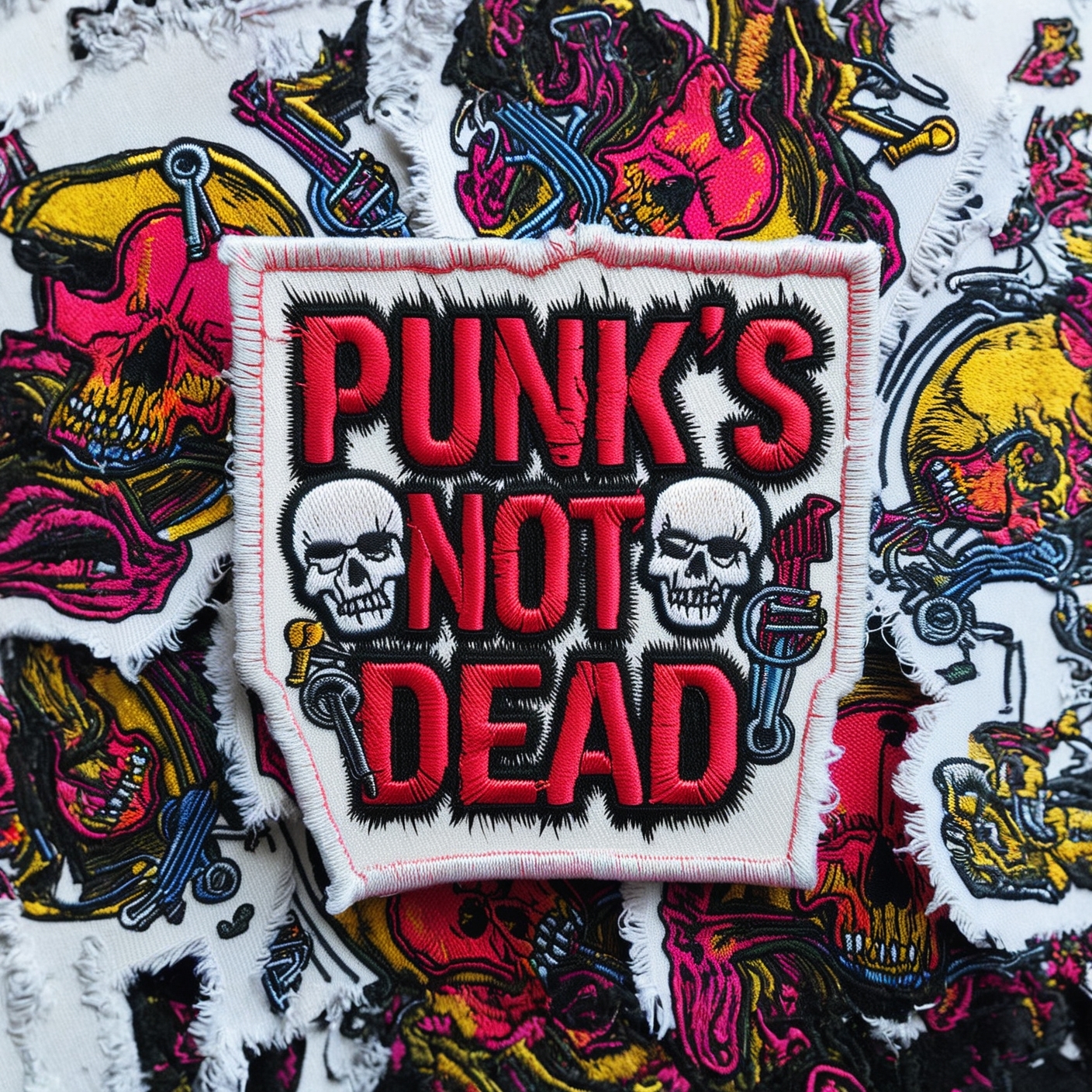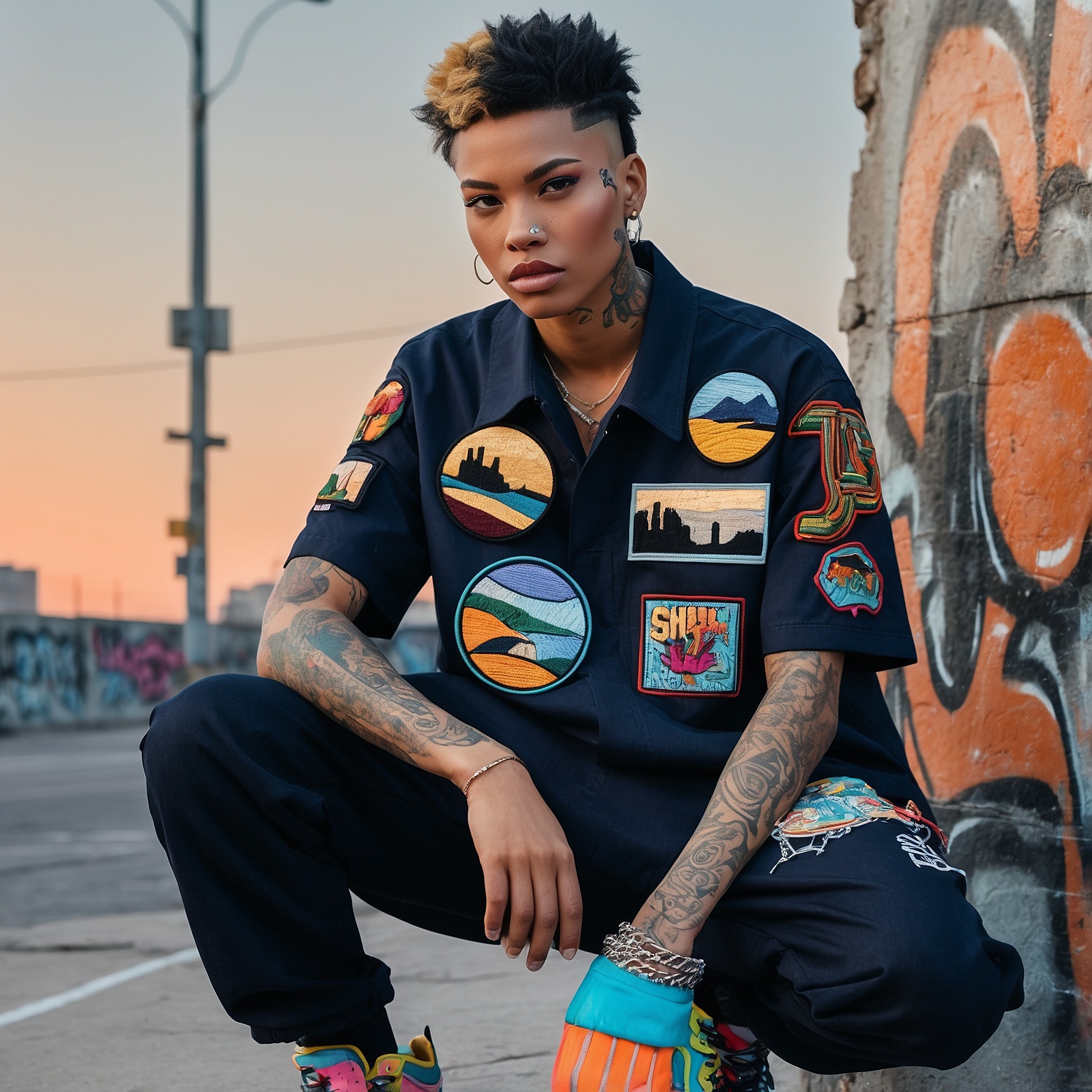Music culture has always been about more than just the sound—it’s a form of expression, identity, and rebellion. Over the decades, music genres and subcultures have often developed their own visual language, allowing fans and artists to communicate their beliefs, values, and allegiance to certain movements or bands. Among the many symbols of this cultural identity, custom patches have emerged as a powerful and enduring icon of music culture, representing everything from punk defiance and rock ‘n’ roll rebellion to heavy metal intensity and indie individuality.
From the jackets of punk rockers covered in band patches to the denim vests of metalheads adorned with intricate logos, custom patches have woven themselves into the very fabric of music culture. These patches have become a symbol of belonging to a particular scene, a way to visually showcase the bands, movements, and ideologies that resonate with each individual. They are more than mere fashion accessories—they are badges of identity, rebellion, and allegiance.
In this article, we will explore how custom patches became icons in music culture, the role they play in expressing identity and community, and the deep connection they have with rebellion and counterculture movements. We’ll also dive into the specific music genres where custom patches have flourished, the creative process behind designing these patches, and how they have evolved over time to maintain their relevance in modern music culture.
The Origins of Custom Patches in Music Culture
The story of custom patches becoming cultural icons in the music world is deeply tied to the history of rebellion, counterculture movements, and the desire to create a sense of belonging within niche communities. Although patches were originally used by military units to signify rank or allegiance, they soon made their way into civilian life, becoming a powerful tool for self-expression—particularly among music fans.
1. The Punk Movement: Rebellion Stitched Into Fabric
The punk movement of the 1970s is often credited with cementing the use of custom patches as a symbol of rebellion within music culture. Born out of dissatisfaction with the mainstream and a desire to challenge societal norms, punk rock was all about nonconformity, DIY ethics, and anti-establishment sentiment. These values were not only expressed in the music but also in the fashion choices of punk fans and artists.
The DIY ethos that punk culture embraced led to the creation of custom patches—often homemade—featuring band logos, political slogans, and anarchist symbols. Patches were sewn onto leather jackets, denim vests, and pants, turning these garments into wearable canvases of rebellion. Bands like the Sex Pistols, The Clash, and Ramones became the visual and sonic inspirations for these patches, as fans proudly adorned themselves with symbols that aligned with their defiance of societal norms.
The rise of custom patches in punk culture also had a deeper meaning: they became a way to challenge the uniformity of mainstream fashion. Instead of buying expensive branded clothes, punk rockers took pride in creating their own looks, often with patched-up clothing that was torn, safety-pinned, and scrawled with graffiti. Each patch was a personal statement, a rejection of commercialism, and a declaration of loyalty to the underground music scene.
2. Heavy Metal: The Birth of the Battle Jacket
As punk rock surged through the 1970s, another genre was gaining momentum that would also embrace the power of custom patches: heavy metal. Known for its aggressive sound, dark imagery, and larger-than-life aesthetic, heavy metal culture created its own visual identity, with custom patches playing a central role.
One of the most iconic symbols of heavy metal fandom is the “battle jacket”—a sleeveless denim or leather vest covered in custom patches. Each patch represents a favorite band, an influential tour, or a personal connection to a specific album. These battle jackets became a way for metalheads to showcase their devotion to bands like Iron Maiden, Metallica, Slayer, and Black Sabbath.
Unlike punk patches, which were often DIY, many metal patches were produced by bands and record labels, becoming highly sought-after pieces of memorabilia. Fans would trade patches or buy them at concerts and festivals, turning the battle jacket into a form of currency within the metal community. The patches themselves were often designed with intricate detail, featuring skulls, fire, gothic lettering, and other dark imagery that reflected the intense, theatrical nature of heavy metal.
3. The Rise of Patch Culture in Alternative and Indie Music
As the 1980s and 1990s unfolded, alternative rock and indie music scenes began to emerge, bringing new sounds and subcultures into the mainstream. While custom patches were already established in punk and metal, they began to spread into alternative and indie scenes, where they were used as symbols of individuality and rejection of the status quo.
In indie music, custom patches often featured minimalist designs, ironic slogans, or band logos that represented a more introspective or anti-commercial mindset. Fans of bands like Sonic Youth, The Pixies, and Nirvana used patches to reflect their identity as part of an alternative subculture that valued authenticity, creativity, and rebellion against mainstream pop culture.
The indie movement also embraced DIY culture, with fans creating their own patches to reflect personal tastes and experiences. This personalization gave patches a unique role within the indie scene—they became a way to visually communicate one’s specific music preferences, often in an understated or ironic way.
The Role of Custom Patches in Music Identity and Community
In music culture, identity is a powerful force that drives the connection between artists, fans, and the broader scene. Custom patches serve as a visual language that helps fans communicate their identity, align with their favorite genres or bands, and signal their belonging to a particular subculture. Let’s explore the deeper role custom patches play in shaping music identity and community.
1. Visual Expression of Loyalty
At their core, custom patches are symbols of loyalty—loyalty to a band, a music genre, or an entire subculture. Fans who sew patches onto their clothing are essentially showcasing their musical allegiances to the world. Whether it’s the patch of a favorite band, a tour they attended, or a festival they participated in, these patches become badges of pride that signify their connection to the music they love.
For fans of niche genres like punk, metal, or indie, wearing these patches also sends a message to others in the community: “I’m one of you.” This visual expression of loyalty helps create a sense of camaraderie among fans, fostering connections at concerts, festivals, and even online spaces. Patches are not just fashion—they are markers of identity and membership in a musical tribe.
2. Fostering a Sense of Belonging
In a world where people seek connection and belonging, custom patches have become powerful symbols of inclusion within music scenes. For many fans, discovering a genre or band that resonates with them can be life-changing, providing a sense of purpose, community, and emotional release. Wearing a patch representing that band or genre allows them to visually signal their affiliation with a larger movement.
The battle jackets of heavy metal culture, for example, are more than just collections of patches—they are statements of belonging to the metal community. Each patch on a battle jacket tells a story of fandom, shared experiences, and connections with fellow metalheads. At concerts and festivals, these patches serve as conversation starters and icebreakers, helping fans bond over their love for the same bands or genres.
In punk culture, custom patches help fans feel connected to the political and social messages embedded in the music. An anarchist patch or anti-authoritarian slogan stitched onto a jacket reflects not only the individual’s beliefs but also their alignment with the broader punk movement. These patches unite fans who share a common desire to challenge the status quo and fight for change, reinforcing their sense of belonging to a community that values rebellion and social justice.
3. Personalization and Creativity
One of the most compelling aspects of custom patches is their ability to be personalized. While many patches are mass-produced by bands or record labels, a large portion of patches in music culture are handmade, designed by fans themselves. This DIY approach allows for a high degree of creativity and individual expression.
Fans often create their own custom patches to reflect their unique tastes, experiences, and personalities. Whether hand-embroidered, painted, or screen-printed, these patches become deeply personal artifacts that capture the essence of the fan’s relationship with the music. This creativity is particularly evident in punk and indie scenes, where fans embrace the DIY ethic and craft their own patches to make a bold statement or send a political message.
The personalization of patches also extends to the way they are arranged on clothing or accessories. Fans carefully curate the placement of their patches, often creating entire narratives or themes with their choices. For example, a battle jacket might feature a progression of patches that reflect the wearer’s musical journey, from their first concert to their favorite album release. Each patch tells a story, making the jacket a wearable timeline of their fandom.
Rebellion, Counterculture, and the Power of Custom Patches
The connection between custom patches and rebellion runs deep. For decades, music has been a driving force in counterculture movements, with genres like punk, metal, and alternative rock providing the soundtrack to social and political upheaval. Patches, as wearable symbols, have become intertwined with the rebellious spirit of these movements. Let’s explore the role of custom patches in expressing rebellion and resistance within music culture.
1. Punk Rock and Political Statements
Punk rock, more than any other genre, has embraced the use of custom patches as tools of political and social protest. Punks have long used their clothing as a form of visual dissent, with patches featuring anarchist symbols, anti-capitalist slogans, and calls for social change. These patches serve as visual declarations of resistance against authority, consumerism, and the status quo.
In the 1970s, the rise of punk in the UK and the US was fueled by widespread dissatisfaction with the government, economic inequality, and conservative social norms. Bands like The Clash and Dead Kennedys used their music to challenge these systems, while fans used patches to align themselves with these radical messages. The iconic “A” symbol for anarchy, the circle-cross symbol of anti-fascism, and the skulls and safety pins of punk fashion became ubiquitous patches on punk jackets, signaling a commitment to rebellion.
Patches also allowed punks to make political statements on an individual level. A handmade patch with the words “No Future” stitched onto a jacket was a personal expression of the disillusionment and frustration that many punks felt in the face of a corrupt political system. These patches were not just accessories—they were acts of defiance, woven into the fabric of punk identity.
2. Metal and Anti-Establishment Imagery
While punk patches often carried explicit political messages, heavy metal patches took a different approach to rebellion, using darker and more theatrical imagery to challenge authority and societal norms. Bands like Slayer, Iron Maiden, and Black Sabbath embraced themes of chaos, death, and destruction, using their music and visual aesthetic to question traditional morality and religious authority.
Metal patches became visual representations of this rebellion, featuring images of skulls, pentagrams, demons, and fire. These patches, prominently displayed on battle jackets, reflected the metal community’s embrace of dark, controversial, and often taboo subjects. The rebellion in metal culture was less about direct political protest and more about rejecting societal expectations and celebrating individualism and freedom.
Much like in punk culture, metal fans used patches to express their alignment with these values. A patch featuring the album cover of Metallica’s Master of Puppets, for example, was a way to visually communicate disdain for authoritarian control and manipulation—a key theme of the album. The patches on a metalhead’s battle jacket told the world that they rejected mainstream culture and embraced the power of personal freedom, no matter how dark or controversial the imagery.
3. DIY Ethics and Independent Spirit in Indie Music
In indie music, custom patches have come to represent the DIY ethics and independent spirit that define the genre. Unlike the aggressive rebellion of punk or metal, indie music’s rebellion is often quieter—an opposition to commercialism, pop culture, and the polished perfection of mainstream music. Indie bands and fans pride themselves on creating music and art that feels authentic, raw, and unfiltered.
Custom patches in the indie scene often feature minimalist designs or ironic slogans, reflecting the understated yet rebellious nature of the genre. Fans might create their own patches with hand-drawn band logos, lyrics from their favorite songs, or designs that reflect their personal interpretation of the music. These patches serve as subtle expressions of individuality and resistance to the mass-produced, overly commercialized world of mainstream music.
In this way, indie fans use custom patches to signal their commitment to authenticity and creativity. They reject the polished, mass-produced aesthetics of pop culture, instead opting for handmade, imperfect patches that align with the DIY values of the indie scene. This quiet rebellion against consumerism and artificiality is at the heart of the indie ethos, and patches serve as wearable representations of this mindset.
The Evolution of Custom Patches in Modern Music Culture
While the origins of custom patches in music culture are deeply rooted in the punk, metal, and indie scenes of the 1970s, 1980s, and 1990s, these patches have continued to evolve and remain relevant in modern music culture. Let’s explore how custom patches have adapted to the changing landscape of music and fashion in the 21st century.
1. Revival of Vintage Aesthetics
In recent years, there has been a revival of vintage aesthetics in both music and fashion, leading to a resurgence in the popularity of custom patches. The rise of retro-inspired genres like garage rock, synthwave, and post-punk has brought back the visual elements of earlier music scenes, including the use of patches as a form of self-expression.
Young fans, inspired by the rebellious fashion of punk and metal, are once again embracing patches as symbols of their musical tastes and identities. Vintage-style patches featuring band logos, album covers, and DIY designs have become highly sought after, with younger generations taking cues from the fashion of the past to create their own modern interpretations.
2. Patches in Streetwear and Fashion
The influence of custom patches has also extended beyond the confines of music subcultures and into the world of streetwear and high fashion. Brands like Supreme, Off-White, and Vetements have incorporated patches into their designs, using them to evoke a sense of rebellion and counterculture. The fusion of music-inspired patches with modern fashion trends has made patches more mainstream while still retaining their roots in underground movements.
This blending of music and fashion has allowed custom patches to reach new audiences, including those who may not be deeply involved in punk or metal scenes but appreciate the rebellious aesthetic that patches represent.
3. Digital Music and Online Communities
While physical patches remain a popular form of expression in live music scenes, the rise of digital music and online communities has transformed the way patches are shared and appreciated. Many fans now purchase custom patches online through platforms like Etsy or Bandcamp, where independent artists and designers sell handmade patches inspired by their favorite bands and genres.
Social media platforms like Instagram and Pinterest have also contributed to the growing popularity of custom patches, as fans share photos of their patch collections, battle jackets, and DIY designs with a global audience. This digital space allows music fans to connect, trade, and discover new patches, further expanding the role of patches in modern music culture.
Conclusion: The Enduring Power of Custom Patches in Music Culture
From the punk rock rebellion of the 1970s to the heavy metal battle jackets of today, custom patches have become enduring symbols of music culture, identity, and rebellion. They have transcended mere fashion accessories to become badges of loyalty, creativity, and individuality. Whether used to express allegiance to a favorite band, signal belonging to a subculture, or make a political statement, patches are woven into the very fabric of music history.
As music culture continues to evolve, custom patches remain a powerful tool for fans and artists alike to communicate their passion, defiance, and connection to the music that defines them. In a world that constantly shifts between the digital and physical, patches offer a tangible, lasting reminder of the role that music plays in shaping our identities and communities. The threads of rebellion, stitched into each patch, continue to inspire and unite music lovers across generations.If you are interested in ordering some high-quality custom patches, feel free to call us at 877-912-6407 or fill out a FREE quote here.



